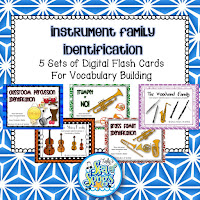It happens every year. It never fails. We reach the end of the school year and a fourth grader excitedly comes up to me in the hallway.
Student: When do we get to take our flutes home?! Me: Flute? I don't have any flutes. Student: You know those things, what are they called?
Now, mind you, I have been calling those things RECORDERS multiple times during each class since October and this child still doesn't know the name of the instrument. This same phenomenon is true for orchestral instruments. Thank heavens for Squidward, we now get clarinet right most of the time.
What is a music teacher to do?
My students have had greater success in
correctly identifying the instruments of the orchestra, both aurally and visually,
since I have built these 4 things into my curriculum.
1. Map Out a Plan to focus on specific
instruments for each grade level based on available resources and field trips. That way, students aren’t trying to memorize
25 instrument names all at the same time.
In my district, we are fortunate to take all second graders to a performance of Carnival of the Animals, third graders to a performance of the Nutcracker Ballet, and fourth graders to a Link-Up concert by the local symphony. These trips have helped me create my plan for introducing the orchestral instruments. I have until October of second grade to be sure the students can identify all of the Carnival instruments, so I spread those out over Kindergarten and first grade. I continued my plan by adding in instruments featured in the Nutcracker, and then in fourth grade, we added in the rest of the major orchestral instruments. I use fifth grade as a review year and put extra focus on the various ways to categorize the instruments.
Students are better able to master the names and families when they are introduced and practiced in smaller sets. Choose your sequence based on the resources that you have available in your school and town. Here is my map:
- Kindergarten: violin, flute, glockenspiel, xylophone, tuba, piano
- First Grade: (review flute & violin), clarinet, trumpet, trombone, double bass
- Second Grade: (review glockenspiel & xylophone), piccolo, viola, cello, harp
- Third Grade: oboe, bassoon, French horn, timpani, bass drum, along with science sound unit-how each instrument makes a sound & how size affects pitch
- Fourth Grade: piccolo, snare drum, cymbals, review classification by families
- Fifth Grade: saxophone, electronic piano, electric guitar, electric bass
2. Use the Vocabulary and provide opportunities for
students to use the vocabulary, spread out over time. Listening
lessons, class games, and center games can distribute
these opportunities across many lessons. Draw pictures of the instruments as you listen, or create a drawing center with sample instrument pictures. Practice writing the instrument names in a journal, or use a "write the room" activity like this one:
I can arrange the instrument posters and names around the room, selecting only those that have been introduced to the students.
Perhaps you already have instrument posters and don't need to purchase the complete set, or perhaps you might like to try this idea before investing any money in a new resource. Check out this free sampler that includes 5 write the room worksheets, but no instrument posters. Students love the scavenger hunt aspect of this type of activity!
I know I am a bit "old school," but there is something about writing things down that just seems to make that information stick in my brain so much better. I think it works for my students, too.
By third grade, we have learned enough instruments to play around the world and team challenge flashcard games. These are fast-paced and really test the students' recall. Read more about flashcard games here:
Sorting instruments into families supports the science curriculum when we focus on how instruments make their sound, and how size affects pitch. Classification by common characteristics is also a science process skill. This is how we, as music educators, support other disciplines without compromising our own discipline.
3. Gamify your review sessions using interactive games such as Boom Cards or interactive PowerPoints. While competition certainly increases engagement, remember to keep the mood light and encouraging for all.
Games constructed in PowerPoint, Google Slides, or Boom Cards are all easily accessible for most classrooms with access to basic technology. The advantages of digital games include the video game-like presentation and the ease of use. No storing of game pieces!
If you've never tried Boom Cards, check out this post on ways to use them in class and in centers, and also find the link to the FREE Feed the Starfish Instrument Family sorting game:
4. Engage ALL of the Learning Modalities
to create stronger neural pathways. Visual, Aural & Kinesthetic modalities are all important!
It is especially helpful to use single instrument recordings when live performance is not possible. I have found some awesome recordings of folk songs played by solo instruments to be very effective, especially in the younger grades. I use these CD's in conjunction with the folk songs that we sing already, along with the visual of the instrument that is playing. I think it helps the students to hear the one instrument playing a song that they know, rather than trying to pick out an instrument from a band or orchestral recording. Aural and visual modalities are easily activated. "Air-play" the instruments and draw pictures while listening to activate the kinesthetic modality.
Don Gato, You Are My Sunshine, and Simple Gifts are published by GIA Music, and each contains 100 FOLK SONGS recorded by a solo instrument with simple accompaniment. That's 300 songs! Don Gato features the string family, while You Are My Sunshine and Simple Gifts feature woodwind, brass, and percussion instruments.
How do these instruments SOUND?
Of course, learning the names and families of orchestra instruments is important, but what about their sound? When teachers don’t have access to high school, college, or professional musicians to visit their classrooms, we have to rely on high-quality video demonstrations.
That’s why I’ve put together a free video collection featuring orchestra instrument performances and demonstrations! Some videos are longer, but most are short clips of individual instruments—perfect for introducing their unique sounds to your students.
🎶 Watch and listen here:
These videos make it easy to bring the sound of the orchestra into your classroom, even if live demonstrations aren’t an option. Pair them with listening maps, movement activities, or simple guided discussions to help students connect the look, name, and sound of each instrument.
Please comment with your favorite teaching tips to help elementary students learn the instruments of the orchestra!
Musically yours,
























.png)


It is remarkable blog. I wanted to learn such type of the things that I have got from here at one platform. Thanks. her comment is here
ReplyDeleteThat’s really so good to visit this site, the blog has helped me a lot in my thesis, before I was quite worried to clear my concepts, thanks Best place for beginners
ReplyDeleteIncredible post.
ReplyDelete